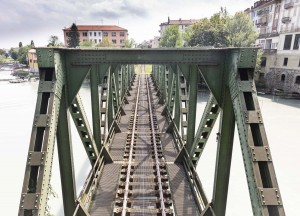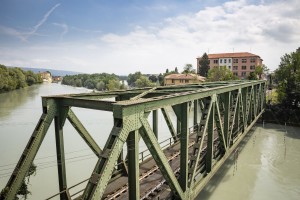
©Bigstock.com/Jorge Anastacio
If you were to look at Ivrea in Piedmont, situated at the northern edge of the Po Valley between Turin and the Aosta Valley, from above, you would notice how the river Dora Baltea pretty much splits it in two. The old town is in the north featuring the ruins of a Roman amphitheatre, the imposing castle of the Savoyard count Amadeus VI and the impressive cathedral that saw many a conversion over the course of centuries. The south, however, is home to an industrial city that sprung up after the foundation of the Olivetti company, grew constantly and furthered Ivrea’s development. On 1 July 2018, the UNESCO declared the industrial city of Ivrea a World Heritage Site. This complex of 27 buildings is widely regarded as the predecessor of corporate architecture and shows you a different side of Northern Italy.
Typewriters, calculators, office computers
Looking at the World Heritage Site Ivrea would not make much sense without checking out the corporate history of Olivetti first. The company was founded by Camillo Olivetti in 1908. Assisted by a few engineers, he developed the typewriter “M1” in a small brick workshop over the course of three years and first presented it on Turin’s industrial fair. Olivetti’s typewriter became a roaring success, the business began to expand counting 200 employees in 1920, around 800 in 1933 and even 6,000 during the war year of 1940. The company specifically recruited its workers from the Ivrea region – once making up 90% of the entire personnel – and developed a revolutionary welfare system from company health insurance to kindergarten, mother welfare to holiday homes, and cultural entertainment to sponsoring the gifted as early as 1909.
Camillo Olivetti, son of a Jewish family, signed his company over to his Adriano to avoid fascistic disseizing. Adriano introduced a new management style and declared the design aspect the major Olivetti feature. Previously introduced office furniture lines and the portable typewriter MP1 “Ico” had already been moving in this direction, dark grey structured coating was introduced later. Olivetti entered the electronic calculator market in 1948, produced the first electronic computers with transistors in 1959. Adriano Olivetti suffered a fatal stroke in 1960 resulting in a dispute among his seven heirs. The passing of company president Giuseppe Pero added further fuel to the fire. This was not the first time the company had to battle financial issues; several reorientations – electronics, computers, telecommunications – only brought temporary relief. After taking over Telecom Italia in 2003 and making it the new parent company, Olivetti finally managed to stabilise and even surprised the world by re-entering the computer market ten years ago.
Movimento Comunità
The social aspect has always been important to Olivetti and the same goes for a clear corporate identity. The “Movimento Comunità” (Eng. “Community Movement”) greatly influenced the buildings of the UNESCO World Heritage Site. Based on Adriano Olivetti’s book “L’Ordine Politico delle Comunità” (Eng. “The Political Order of the Community”), it was introduced in 1947. The movement demanded a restructuring of the country into autonomous municipalities united by a shared cultural background. Unlike other industrialists, Olivetti realised the necessity of protecting his employees and providing social services. His provision of residential buildings met the rapid industrial – and thereby social – changes of the 20th century. As such, this UNESCO World Heritage Site is not just architecturally impressive, but also as a testament to the history of political thought behind it – even though the functions of most commercial buildings declined substantially in recent years.
Extraordinary architecture marking industrial change

©Bigstock.com/Jorge Anastacio
Even though AEG had buildings designed in accordance with their corporate identity as early as the 1910s, Olivetti is widely regarded as the pioneer of corporate architecture. Introduced during the 1930s, these buildings fulfilled social capacities and created an identity resulting in brand awareness and recognition value which, in turn, increased workforce productivity. The one-of-a-kind arrangement of the Olivetti complex – conceived and built under the direction of Adriano Olivetti and leading Italian architects utilising Olivetti’s political and social concepts – symbolises a changing industry. Mechanical things were digitised, production mechanisms introduced, social changes incorporated. Every single building, every part of this complex is fully thought through, reflects the corporate identity and is still seamlessly integrated into the townscape. It should come as no surprise that Olivetti’s buildings became major cornerstones for the development of theories about industrialisation and urban development in the 20th century.
27 buildings, one World Heritage Site
70.000 hectares of total area, 145,000 m² of built-up space, 17% of which serve as flats – the Olivetti complex wows with its monumental dimensions. The World Heritage Site encompasses 27 buildings, most of which are used differently these days. They include the heating plant and the carpentry, the former Sertec building and the social housing building Borgo Olivetti, the building 18 alloggi and the housing estate west, which was only planned in 1968. They all bear the signatures of renowned architects while also being highly characteristic of Olivietti’s style that continues to mould the world of corporate architecture to this very day. The company kindergarten shows that father and son were far ahead of their time. Conceived in 1939, the rooms are still used as municipal childcare facilities.
It goes without saying that there are far more striking, dazzling company buildings today with wild design ideas and humongous dimensions. Still, Ivrea’s industrial complex remains special, unique. Experience how Italy changed during the industrialisation during a brief walk around the south of the town. While you are at it, visit the old town in the north with its equally impressive structures. Experience over two thousand years of highly eventful history in fast motion when marvelling at Ivrea.